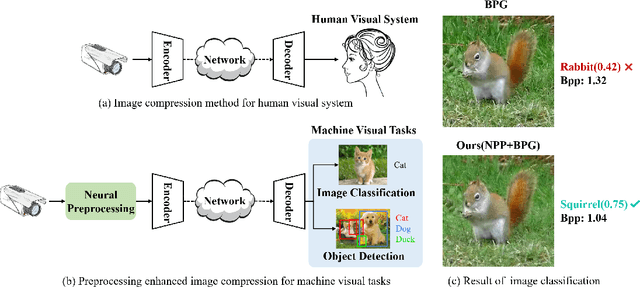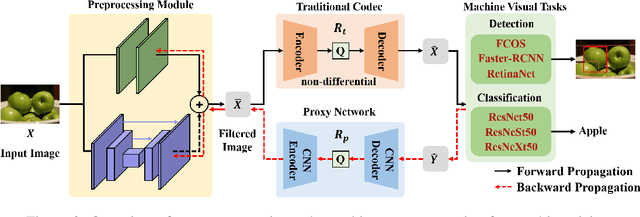Xingtong Ge
Condition Weaving Meets Expert Modulation: Towards Universal and Controllable Image Generation
Aug 24, 2025Abstract:The image-to-image generation task aims to produce controllable images by leveraging conditional inputs and prompt instructions. However, existing methods often train separate control branches for each type of condition, leading to redundant model structures and inefficient use of computational resources. To address this, we propose a Unified image-to-image Generation (UniGen) framework that supports diverse conditional inputs while enhancing generation efficiency and expressiveness. Specifically, to tackle the widely existing parameter redundancy and computational inefficiency in controllable conditional generation architectures, we propose the Condition Modulated Expert (CoMoE) module. This module aggregates semantically similar patch features and assigns them to dedicated expert modules for visual representation and conditional modeling. By enabling independent modeling of foreground features under different conditions, CoMoE effectively mitigates feature entanglement and redundant computation in multi-condition scenarios. Furthermore, to bridge the information gap between the backbone and control branches, we propose WeaveNet, a dynamic, snake-like connection mechanism that enables effective interaction between global text-level control from the backbone and fine-grained control from conditional branches. Extensive experiments on the Subjects-200K and MultiGen-20M datasets across various conditional image generation tasks demonstrate that our method consistently achieves state-of-the-art performance, validating its advantages in both versatility and effectiveness. The code has been uploaded to https://github.com/gavin-gqzhang/UniGen.
Rethinking Diffusion Posterior Sampling: From Conditional Score Estimator to Maximizing a Posterior
Jan 31, 2025Abstract:Recent advancements in diffusion models have been leveraged to address inverse problems without additional training, and Diffusion Posterior Sampling (DPS) (Chung et al., 2022a) is among the most popular approaches. Previous analyses suggest that DPS accomplishes posterior sampling by approximating the conditional score. While in this paper, we demonstrate that the conditional score approximation employed by DPS is not as effective as previously assumed, but rather aligns more closely with the principle of maximizing a posterior (MAP). This assertion is substantiated through an examination of DPS on 512x512 ImageNet images, revealing that: 1) DPS's conditional score estimation significantly diverges from the score of a well-trained conditional diffusion model and is even inferior to the unconditional score; 2) The mean of DPS's conditional score estimation deviates significantly from zero, rendering it an invalid score estimation; 3) DPS generates high-quality samples with significantly lower diversity. In light of the above findings, we posit that DPS more closely resembles MAP than a conditional score estimator, and accordingly propose the following enhancements to DPS: 1) we explicitly maximize the posterior through multi-step gradient ascent and projection; 2) we utilize a light-weighted conditional score estimator trained with only 100 images and 8 GPU hours. Extensive experimental results indicate that these proposed improvements significantly enhance DPS's performance. The source code for these improvements is provided in https://github.com/tongdaxu/Rethinking-Diffusion-Posterior-Sampling-From-Conditional-Score-Estimator-to-Maximizing-a-Posterior.
MEGA: Memory-Efficient 4D Gaussian Splatting for Dynamic Scenes
Oct 17, 2024Abstract:4D Gaussian Splatting (4DGS) has recently emerged as a promising technique for capturing complex dynamic 3D scenes with high fidelity. It utilizes a 4D Gaussian representation and a GPU-friendly rasterizer, enabling rapid rendering speeds. Despite its advantages, 4DGS faces significant challenges, notably the requirement of millions of 4D Gaussians, each with extensive associated attributes, leading to substantial memory and storage cost. This paper introduces a memory-efficient framework for 4DGS. We streamline the color attribute by decomposing it into a per-Gaussian direct color component with only 3 parameters and a shared lightweight alternating current color predictor. This approach eliminates the need for spherical harmonics coefficients, which typically involve up to 144 parameters in classic 4DGS, thereby creating a memory-efficient 4D Gaussian representation. Furthermore, we introduce an entropy-constrained Gaussian deformation technique that uses a deformation field to expand the action range of each Gaussian and integrates an opacity-based entropy loss to limit the number of Gaussians, thus forcing our model to use as few Gaussians as possible to fit a dynamic scene well. With simple half-precision storage and zip compression, our framework achieves a storage reduction by approximately 190$\times$ and 125$\times$ on the Technicolor and Neural 3D Video datasets, respectively, compared to the original 4DGS. Meanwhile, it maintains comparable rendering speeds and scene representation quality, setting a new standard in the field.
Task-Aware Encoder Control for Deep Video Compression
Apr 07, 2024



Abstract:Prior research on deep video compression (DVC) for machine tasks typically necessitates training a unique codec for each specific task, mandating a dedicated decoder per task. In contrast, traditional video codecs employ a flexible encoder controller, enabling the adaptation of a single codec to different tasks through mechanisms like mode prediction. Drawing inspiration from this, we introduce an innovative encoder controller for deep video compression for machines. This controller features a mode prediction and a Group of Pictures (GoP) selection module. Our approach centralizes control at the encoding stage, allowing for adaptable encoder adjustments across different tasks, such as detection and tracking, while maintaining compatibility with a standard pre-trained DVC decoder. Empirical evidence demonstrates that our method is applicable across multiple tasks with various existing pre-trained DVCs. Moreover, extensive experiments demonstrate that our method outperforms previous DVC by about 25% bitrate for different tasks, with only one pre-trained decoder.
Content-aware Masked Image Modeling Transformer for Stereo Image Compression
Mar 20, 2024Abstract:Existing learning-based stereo image codec adopt sophisticated transformation with simple entropy models derived from single image codecs to encode latent representations. However, those entropy models struggle to effectively capture the spatial-disparity characteristics inherent in stereo images, which leads to suboptimal rate-distortion results. In this paper, we propose a stereo image compression framework, named CAMSIC. CAMSIC independently transforms each image to latent representation and employs a powerful decoder-free Transformer entropy model to capture both spatial and disparity dependencies, by introducing a novel content-aware masked image modeling (MIM) technique. Our content-aware MIM facilitates efficient bidirectional interaction between prior information and estimated tokens, which naturally obviates the need for an extra Transformer decoder. Experiments show that our stereo image codec achieves state-of-the-art rate-distortion performance on two stereo image datasets Cityscapes and InStereo2K with fast encoding and decoding speed.
GaussianImage: 1000 FPS Image Representation and Compression by 2D Gaussian Splatting
Mar 14, 2024



Abstract:Implicit neural representations (INRs) recently achieved great success in image representation and compression, offering high visual quality and fast rendering speeds with 10-1000 FPS, assuming sufficient GPU resources are available. However, this requirement often hinders their use on low-end devices with limited memory. In response, we propose a groundbreaking paradigm of image representation and compression by 2D Gaussian Splatting, named GaussianImage. We first introduce 2D Gaussian to represent the image, where each Gaussian has 8 parameters including position, covariance and color. Subsequently, we unveil a novel rendering algorithm based on accumulated summation. Remarkably, our method with a minimum of 3$\times$ lower GPU memory usage and 5$\times$ faster fitting time not only rivals INRs (e.g., WIRE, I-NGP) in representation performance, but also delivers a faster rendering speed of 1500-2000 FPS regardless of parameter size. Furthermore, we integrate existing vector quantization technique to build an image codec. Experimental results demonstrate that our codec attains rate-distortion performance comparable to compression-based INRs such as COIN and COIN++, while facilitating decoding speeds of approximately 1000 FPS. Additionally, preliminary proof of concept shows that our codec surpasses COIN and COIN++ in performance when using partial bits-back coding.
Boosting Neural Representations for Videos with a Conditional Decoder
Mar 08, 2024



Abstract:Implicit neural representations (INRs) have emerged as a promising approach for video storage and processing, showing remarkable versatility across various video tasks. However, existing methods often fail to fully leverage their representation capabilities, primarily due to inadequate alignment of intermediate features during target frame decoding. This paper introduces a universal boosting framework for current implicit video representation approaches. Specifically, we utilize a conditional decoder with a temporal-aware affine transform module, which uses the frame index as a prior condition to effectively align intermediate features with target frames. Besides, we introduce a sinusoidal NeRV-like block to generate diverse intermediate features and achieve a more balanced parameter distribution, thereby enhancing the model's capacity. With a high-frequency information-preserving reconstruction loss, our approach successfully boosts multiple baseline INRs in the reconstruction quality and convergence speed for video regression, and exhibits superior inpainting and interpolation results. Further, we integrate a consistent entropy minimization technique and develop video codecs based on these boosted INRs. Experiments on the UVG dataset confirm that our enhanced codecs significantly outperform baseline INRs and offer competitive rate-distortion performance compared to traditional and learning-based codecs.
Preprocessing Enhanced Image Compression for Machine Vision
Jun 12, 2022



Abstract:Recently, more and more images are compressed and sent to the back-end devices for the machine analysis tasks~(\textit{e.g.,} object detection) instead of being purely watched by humans. However, most traditional or learned image codecs are designed to minimize the distortion of the human visual system without considering the increased demand from machine vision systems. In this work, we propose a preprocessing enhanced image compression method for machine vision tasks to address this challenge. Instead of relying on the learned image codecs for end-to-end optimization, our framework is built upon the traditional non-differential codecs, which means it is standard compatible and can be easily deployed in practical applications. Specifically, we propose a neural preprocessing module before the encoder to maintain the useful semantic information for the downstream tasks and suppress the irrelevant information for bitrate saving. Furthermore, our neural preprocessing module is quantization adaptive and can be used in different compression ratios. More importantly, to jointly optimize the preprocessing module with the downstream machine vision tasks, we introduce the proxy network for the traditional non-differential codecs in the back-propagation stage. We provide extensive experiments by evaluating our compression method for two representative downstream tasks with different backbone networks. Experimental results show our method achieves a better trade-off between the coding bitrate and the performance of the downstream machine vision tasks by saving about 20% bitrate.
 Add to Chrome
Add to Chrome Add to Firefox
Add to Firefox Add to Edge
Add to Edge